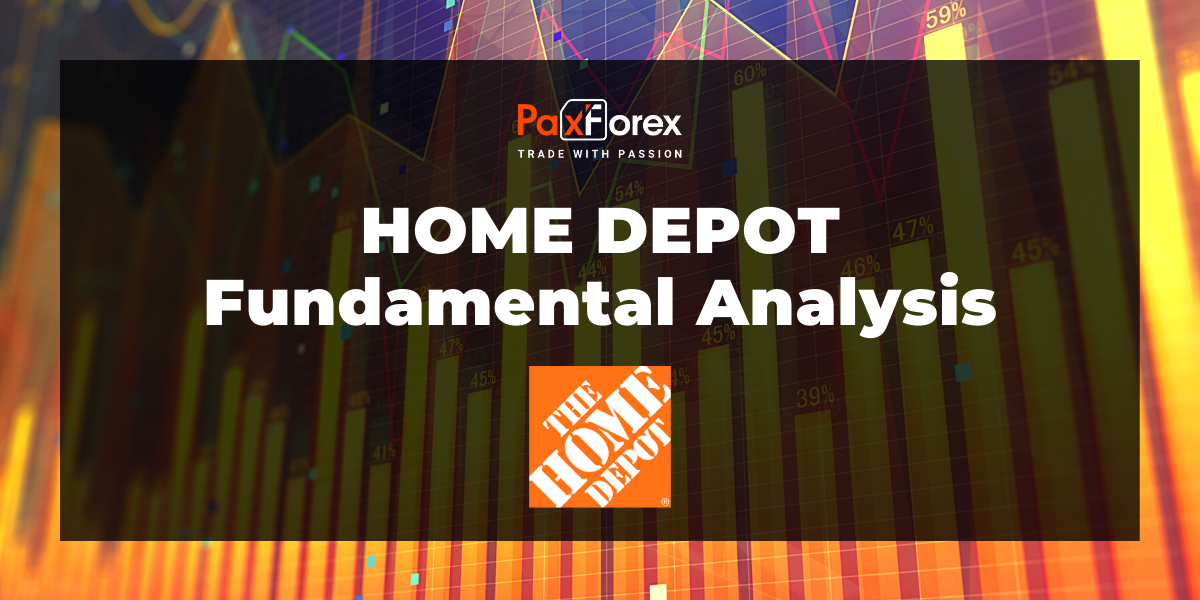
Source: PaxForex Premium Analytics Portal, Fundamental Insight
The pandemic forced many companies to send their employees to work remotely. Millions of employees who were used to appearing in their offices every day had to make significant adjustments to their work.
Home Depot stock ended the Dec. 7 trading session at a record high of $416.18 per share. The home improvement dealer has been a jaw-dropper winner since the start of the pandemic as people diverted their spare cash to improve their homes. Since March last year, Home Depot stock is up 160%.
Since the stock is still close to its all-time high, you might wonder if Home Depot is a good investment at the moment.
The company posted another fantastic quarterly earnings (for Q3 ended Oct. 31), surpassing Wall Street consensus forecasts on both the top and bottom line. Revenue of $36.8 billion and diluted earnings per share of $3.92 were 9.8% and 23.3% higher than the previous year, respectively. Same-store sales were up 6.1% year over year. Considering the harsh comparison to last year`s Q3, this was a great report from Home Depot.
For the third quarter in a row, sales from professional customers, which include contractors, plumbers, and electricians, outperformed the DIY segment. During the pandemic, consumers refrained from more complicated projects since they weren't comfortable letting outsiders into their homes, but that dynamic has since changed. Almost half of Home Depot's sales come from professionals, so it's great to see this cohort of customers successfully recovering.
Although customer transactions were down 5.5% in Q3, the average ticket size was up 12.9%, due in part to inflation across some product categories. Home Depot's operating margin was 15.7% and its ROIC) was an excellent 43.9%. Operating margin and ROIC outperformed competitor Lowe's since Home Depot has a larger Pro business, with professional contractors who frequent the store and spend more, resulting in better financial performance.
As per management, Q4 got off to a fantastic start. "Combined sales for the first two weeks of the fourth quarter are slightly higher than the entire third quarter," Chief Financial Officer Richard McPhail said during the third-quarter earnings call.
One of the essential tendencies contributing to Home Depot's business growth is rising home prices. Due to the U.S. housing shortage, median prices in October rose 13 percent year over year to $378,700, marking the 15th consecutive month of double-digit growth. The popularity of remote work has made many Americans reassess their housing conditions, which has supported activity in the housing market as well.
Growing prices are having a wealth effect on consumers, who are looking at remodeling projects as an investment in their homes. Using skyrocketing equity is one way to finance projects. According to CoreLogic, U.S. homeowners with mortgages added $3.2 trillion in home equity in the third quarter, a 31.1% increase over the previous year.
And even if the Federal Reserve plans to raise interest rates at some point in 2022, they will still be at historically low levels. So this is hardly a potential obstacle to Home Depot's business.
Nevertheless, if consumers shift their spending away from home improvement projects to other retail categories, demand for Home Depot could dilute. This would surely put pressure on the company's stock. However, based on last quarter's financial performance, the company's momentum could not be stronger at the moment.
As of Dec. 15, Home Depot stock was trading at a price-to-earnings (P/E) ratio of 27, the second-highest in a decade. The P/E ratio in the S&P 500 is nearly 29, so Home Depot looks like an engaging stock to own based on that comparison alone. But the company's business is much better than the average company, which strengthens the bulls' argument for the stock at the moment.
With consistent revenue and earnings growth throughout its long history, Home Depot has already evinced its investment merits. And with its enormous scale in the home goods industry, the company is a fundamental part of today's U.S. economy. Even near its all-time high, the company's stock deserves serious consideration as an investment for your portfolio.
As long as the price is above the 386.00 level, follow the recommendations below:
- Time frame: D1
- Recommendation: long position
- Entry point: 402.20
- Take Profit 1: 425.00
- Take Profit 2: 434.00
Alternative scenario:
If the level of 386.00 is broken-down, follow the recommendations below:
- Time frame: D1
- Recommendation: short position
- Entry point: 386.00
- Take Profit 1: 370.00
- Take Profit 2: 360.00













